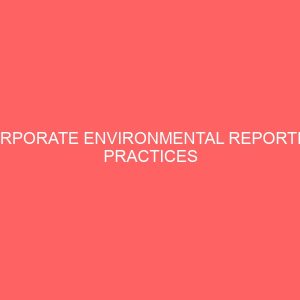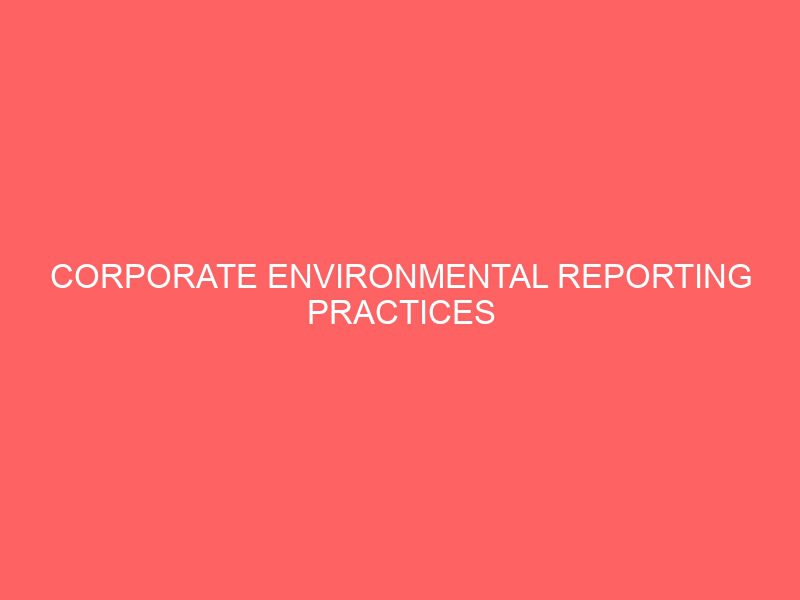Description
Environmental issues have emerged in recent decades as a major aspect of the discussion of the
problems of economic growth and development. Environmental problems associated with
industrial activities in the final decades of the last century have heightened public concerns about the non-financial performance of corporations and increased pressure for the disclosure of environmental information. Over the past decades, there have been plethoras of literature on
corporate environmental disclosures, including studies majorly from developed countries, while
the same is not true of developing countries, particularly Nigeria. Moreso, while there is an
extensive research on the role of the Global Reporting Initiative and the International
Organization for Standardization (ISO) guidelines in determining corporate environmental
performance indicators and the extent of disclosures in annual report in developed economies, in contrast, there is a dearth of studies conducted in the context of developing economies. To this end, this research investigated the extent and nature of corporate environmental reporting
practice among listed firms in Nigeria and South Africa. Also, using the stakeholder theory as
motivation for corporate environmental disclosures, the research examined the perception lobby
groups on the disclosure of environmental performance information and the corporate
relationship with host community. To achieve this, a grand total of 900 copies of questionnaire
were distributed among members of the selected state/provinces using the Yaro Yamani sample
selection formula in determine the sample size of the study. In addition, while the content
analysis technique was used as a basis for eliciting data from the annual report and corporate
websites of the selected companies, the multiple regression method of data analysis was used to
investigate the relationships that exist between operating performance, financial leverage
(nature), size of firms‟ and the level of corporate environmental disclosure among the selected
listed firms in Nigeria and South Africa. The research as part of its findings observed that there is a significant positive relationship between the operating performance, size of firms and the level of corporate environmental disclosures among selected firms in Nigeria. This is however
consistent with existing prior studies. The study also observed that a significant negative
relationship exists between the financial leverage of firms (proxied by debt -to-equity ratio) and the extent of corporate environmental disclosure. The study therefore concludes that despite the disclosure level noticed among firms, corporate environmental reporting practice in developing countries like Nigeria and South Africa is still very adhoc, general, self-laudatory and voluntary in nature.
Title Page ————————————————————–.. i
Declaration————————————————————– ii
Certification————————————————————.. iii
Dedication————————————————————–. iv
Acknowledgements——————————————————– v
Abstract—————————————————————-.. vi
Table of Content———————————————————- vii
List of Tables————————————————————. viii
List of Figures———————————————————— ix
Appendices————————————————————– x
Acronyms and Definitions————————————————–. xi
CHAPTER ONE: Introduction
1.0 Background of the Study————————————————– 1
1.1 Statement of Research Problem—————————————-.. 5
1.2 Objectives of Study————————————————–. 8
1.3 Research Questions——————————————————————.. 9
1.4 Research Hypotheses—————————————————————— 9
1.5 Significance of the Study——————————————–.. 10
1.6 Justification of Study————————————————.. 11
1.7 Scope and Limitation of Study—————————————— 11
1.8 Summary of Research Methodology————————————.. 14
1.9 Sources of Data —————————————————-. 15
CHAPTER TWO: Literature Review and Theoretical Framework
2.0 Introduction ————————————————–.—- 23
2.1 The Concept of Social Responsibility Accounting and Environmental
Accounting——————————————————–. 23
2.2 What is Environmental Accounting——————————..——.. 25
2.3 The Emergence of Environmental Accounting————————–..–. 28
2.4 Scope of Environmental Accounting—————————-..——– 30
2.5 What are Environmental Costs——————————————. 31
2.5.1 Identification of Environmental Costs———-..————.. 31
2.6 Corporate Environmental Reporting————————..————. 35
2.6.1 Types of Environmental Reporting————————–.. 39
2.6.2 The Principles of Environmental Reporting——————– 41
2.6.3 Why voluntary environmental reporting———————-.. 43
2.7 Global Environmental Reporting Practices——————————–.. 45
2.7.1 Environmental Reporting Development in Europe————–. 46
2.7.2 North American Environmental Reporting Practice————– 48
2.7.3 The Asian Experience in Environmental Reporting———-..–.. 50
2.7.4 The Development of Environmental Reporting in-Australia——.. 50
2.7.5 Environmental reporting in African Continent———-.——.. 52
2.7.6 The Nigerian Scenario————————————. 52
2.7.7 Historical Background on Environmental Regulation in Nigeria-and Firms‟ Attitude————————————————–.. 54
2.7.8 Environmental Waste Management Laws in Nigeria————. 56
2.7.9 The Nigerian Environmental Laws / Regulations and the
Prescribed Sanctions———————————-.. 56
2.8.0 The South African Scenario——————..————. 59
2.9 Prior Research on Company Characteristics & Corporate Environmental
Reporting——————..————————————–.. 60
2.10 Theoretical Framework————————————————————–.. 77
2.10.1 Framework for Environmental Reporting————————–. 77
2.10.2 Political Economy Theory——————————————. 78
2.10.3 Legitimacy Theory————————————————– 81
2.10.4 Stakeholder Theory————————————————.. 85
2.10.5 Stakeholder Theory and Corporate Environmental
Reporting———————————————-90
2.10.6 Environmental Disclosures and Relevant Financial Reporting-Standards——————————————–.. 91
2.10.7 Environmental Performance Indicators————.——–.. 97
2.10.8 Types Environmental Performance Indicators———-..—-.. 98
2.10.9 Overview of ISO————————————–.. 101
CHAPTER THREE: Research Methods
3.0 Introduction——————————.————————– 127
3.1 Research Design————————————–..————– 127
3.2 Study Population————–.———————————-..–.. 129
3.3 Sample Size and Sampling Technique for Secondary Data——————– 129
3.4 Sample Size and Sampling Technique for Primary Data————————.. 130
3.5 Data Gathering Method—————————————-..——. 131
3.5.1 Sources of Data—————————————-.. 131
3.5.2 Research Instruments————————————.. 132
3.5.3 Validity and Reliability of Instrument————————. 135
3.5.4 Actual Field Work and Administration of Questionnaire
Instruments——————————————–. 136
3.5.5 Method of Presentation————————..———-. 137
3.6 Data Analysis Method——————————–.—————- 137
CHAPTER FOUR: Data Analysis and Result Presentation
4.0 Introduction————————————–.—————-.. 148
4.1 Data Presentation and Analysis——————————————————. 148
4.1.1 Results on Incidence of Corporate Environmental Disclosure
——————..———————————-. 149
4.1.2 Content “Category Themes of Corporate Environmental
Disclosure—————————————————-.. 151
4.1.3 Content-Category Disclosure of Environmental-Information by Evidence————————..——– 154
4.1.4 Content-Category Disclosure of Environmental-Information by Location——————————————–.. 157
4.1.5 Content-Category Disclosure of Environmental-Information by News-Type——————————– 158
4.2 Data Analysis——————————————————– 159
4.2.1 Descriptive statistics on the level of Corporate Environmental
Disclosure between Nigerian and South African firms——–.. 159
4.2.2 Impact of Size, Operating Performance and Nature of -Firms on Level of Corporate Environmental Disclosure ——–.. 160
4.2.3 Overall Findings from the Two Countries———-.———- 160
4.2.4 Descriptive Statistics for Averaged ROTA, D/E Ratio,
Size and EDISC for Selected firms in Nigeria———————-. 161
4.2.5 Descriptive Statistics for Averaged ROTA, D/E Ratio,
Size and EDISC for Selected Firms in South Africa—————- 162
4.2.6 Correlation Coefficient Analysis of the Relationship between the-averaged ROTA, D/E Ratio, Size and EDISC for firms in
Nigeria1———————————————-..164
4.2.7 Correlation Coefficient Analysis of the Relationship between
the averaged ROTA, D/E Ratio, Size and EDISC for firms in
South Africa——————————————–167
4.2.8 Regression Analysis Results—————————————-.. 168
4.3 Presentation of Survey Results——————————————————.. 170
4.3.1 Personal Bio-Data of Respondents————————– 172
4.3.2 Descriptive Statistics of Respondents——————————– 175
4.3.3 Reponses on Environmental Regulation/Protection————.. 176
4.3.4 Reponses on Firms‟ Environmental Disclosure Level——–.–.. 178
4.3.5 Reponses on Respondents on ED as it Influence the activities of-Lobby Groups—————————————— 182
4.4 Hypotheses Testing———————————-..————–.. 186
CHAPTER FIVE: Summary of Findings, Conclusion and Recommendations
5.0 Introduction——————. ——————————————————. 194
5.1 Summary of Work Done——————..————————–. 194
5.2 Summary of Findings————————————————. 195
5.2.1 Theoretical Findings————————————.. 195
5.2.2 Empirical Findings————————————————–.. 197
5.3 Conclusion————————————————————————–.. 202
5.4 Recommendations and Implication of study——————————..203
5.5 Contribution to Knowledge——————————————————–.. 207
References————————————————————–. 210
Table 2.0 Oil Spillage Data in Nigeria (Niger Delta)————————–54
Table 4.0 Industry Based Analysis on Averaged Environmental Disclosure for -Selected Firms in Nigeria————————————–.. 150
Table 4.1 Industry Based Analysis on Averaged Environmental Disclosure for -Selected Firms in South Africa———————————-.. 151
Table 4.2 Averaged Content-Category Theme of Environmental Disclosure for-Selected Industries in Nigeria——————————–. 153
Table 4.3 Averaged Content-Category Theme of Environmental Disclosure for-Selected Industries in South Africa——————————.. 154
Table 4.4 Descriptive Statistics for Content Category of Themes Disclosure———— 154
Table 4.5 Averaged Content-Category Disclosures by Evidence for Selected -Industries in Nigeria——————————————.. 156
Table 4.6 Averaged Content-Category Disclosures by Evidence for Selected -Industries in South Africa————————————–.. 156
Table 4.7 Averaged Content-Category Disclosures by Location for Selected -Industries in Nigeria & South Africa——————————. 157
Table 4.8 Averaged Content-Category Disclosures by News Type for Selected-Industries in Nigeria & South Africa——————————. 158
Table 4.9 Z-test Two Sample Means———————————-.. 159
Table 4.10 Descriptive Statistics for selected Nigerian firms———-..———- 162
Table 4.11 Descriptive Statistics for selected South African firms————.—- 164
Table 4.12 Classification of Correlation——————..—————— 164
Table 4.13 Correlations (Pearson) for Selected Listed Firms in Nigeria———-.– 166
Table 4.14 Correlations (Pearson) for selected firms in South Africa———-.—- 168
Table 4.15 Summarized Regression Results on the Relationship between Size,
Operating Performance and the Nature of firms on the level of
Corporate Environmental Disclosure from both Countries————. 170
Table 4.16(a) Response to Questionnaire——————.——————– 171
Table 4.16(b) Summary of Questionnaire Administered————————–.. 171
Table 4.17 Bio-Data of Respondents——————..——————–. 173
Table 4.18 Distribution of Respondents on Environmental
Regulation/Protection——————————————..176
Table 4.19 Distribution of Respondents on Firms‟ Environmental Disclosure Level–. 179
Table 4.20 Distribution of Respondents in both countries on Environmental
Disclosure as it Influence the Activities of Lobby Groups————–.182








Reviews
There are no reviews yet.